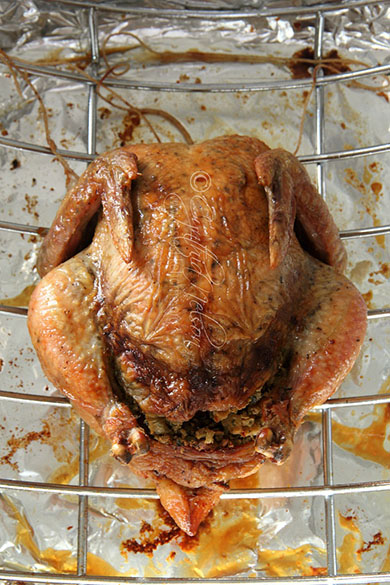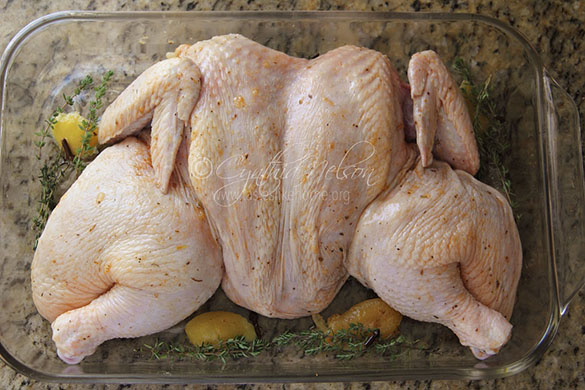What’s Cooking is a series in which I answer questions and share advice about food and cooking that you may have but are too shy to ask.
Reader question: Is there a difference between roast chicken and baked chicken?
Yes. There is a difference between roast chicken and baked chicken. Even though both are cooked in an oven, and we refer to things cooked in the oven as being “baked”, the difference lies in the preparation of the meat – cut or whole, the seasoning of the meat, the cooking pan and oven temperature.
Let’s start by looking at the preparation of the chicken.

Whole & Cut
Roasts are usually large cuts of meat – leg of lamb, pork, beef prime rib. In poultry we’re talking whole turkey, duck and more specifically here, a whole chicken. Sometimes, the chicken can be butterflied – split open and spread flat to be cooked, or halved. Most of the times though, a roast chicken is left whole. On the other hand, when chicken is baked, it is jointed – legs, thighs, wings, back halved crossways and the breast quartered – yielding 12 pieces. Right away you can see that roasting or baking the chicken will require different cooking times – the roast chicken will take longer, because it is larger, and the baked chicken will take less time because it is broken down into smaller pieces.
Seasoning
Roast chickens are often seasoned with a dry or powdered, flavoured seasoning in addition to salt and black pepper and sometimes a paste. The reason for this is because a roast is cooked with the dry hot air bouncing off the oven walls, slowly cooking the meat and ultimately browning and crisping the skin – the prized part of roasts. If the seasonings are liquid or moist, the skin will not crisp up and if you add certain liquid seasonings, you may find the outside browning faster than the meat is cooking, sometimes even burning. However, glazes can be added to roasts by brushing them on about 5 – 10 minutes before the meat is done cooking or perhaps just as it is pulled from the oven.

The seasoning for baked chicken can made up of a variety powdered flavourings, pastes, such as green seasoning and flavour liquids like soy sauce, Worchester sauce, Oyster sauce, wine, browning, citrus juices or fruit juices, rum, pepper sauce, or bottled sauces simply labelled as seasoning. This liquid marinade in which the chicken is cooked (baked) easily penetrates the meat, making it juicy and very flavourful, literally, right down to the bone. As the chicken cooks, the marinade concentrates and turns into a sauce that is served along with meat. Here is the thing, even though the chicken is being cooked in the same hot dry air of the oven, the liquid that surrounds the meat keeps it juicy and moist, and with the shortened cooking time than that of a roast chicken, the meat browns thanks to the dark liquid marinades.
With roast chicken, there is no such self-saucing as there is with baked chicken; there are the concentrated drippings – oil from the chicken and brown bits stuck at the bottom of the pan, from which a gravy can then be made to serve with the roast. The combination makes a very delicious gravy to accompany the roast.
A note on seasoning: Whole chickens can be seasoned and refrigerated overnight. When ready to cook, bring up to room temperature and pat dry with paper towels before going in to the oven. Baked chicken benefit greatly from an overnight marinate. Bring to room temperature and transfer meat and marinade to baking dish before putting in the oven.
So, from the preparation and seasoning of the chicken, you can see how roast chicken is different from baked chicken. However, there are a couple of other things that I want to point out to you.
Pans
The cooking pan plays a role in how the meat is cooked. If you are making roast chicken, opt for a pan with a rack. Resting the chicken on a rack as it cooks allows for the heat to circulate evenly around the meat and not sit in the pool of juices that accumulate as it cooks. Of course if you do not have a pan with a rack, you can still roast a chicken, it’s just that all the parts of the chicken touching the bottom of the pan will yield soggy skin.
For baked chicken, use a pan that is at least 2 inches deep, 3 inches is ideal. Too often I have seen people baking chicken in sheet pans only to have all the marinade evaporate, and the chicken dried out. It is such a shame and a waste. They then make gravy to pour over the chicken to plump it up because it is so dry. The gravy only helps on the surface though, because the juice from the chicken itself has already been extracted and dried out. If you bake the chicken in a deep enough dish, you do not have to cover it with foil to prevent it drying out.
Here’s why the sheet pans are not recommended for baking chicken – apart from being flat, they provide no protection from the dry hot air of the oven, so the marinade and juices quickly and easily evaporate. Baking the chicken in a deep dish allows the air to circulate at the top, under and around the dish as the meat cooks surrounded by juices.
Oven Temperature
There are many schools of thoughts on the temperature for roasting chicken – some cook at a steady high temperature, others a high temperature at the start and then drop to a lower temperature and then there are those that start at a low temperature and move to a higher temperature to finish the cooking process. Many times, I have simply roasted the chicken low and slow. The raising and lowering temperatures for roast chicken really have to do with browning the chicken, giving it a bit of colour and making the skin enticingly crisp, or, rendering the fat from the skin so that when the chicken is tented (covered with foil after roasting), it becomes soft and delectable with the meat.
Baking chicken is much easier with temperature – a steady 350F degrees will get you where you want to go every time. Most baked chicken is done cooking in about 45 minutes (depending on quantity and size of cuts), while a whole roast chicken (depending on size) can take anywhere from 1½ to 3 hours. Butterflying the bird shaves about half an hour off the cooking time. To butterfly the chicken is to remove the spinal backbone, cutting the chicken in half and flattening the chicken.
The plus side of roasting a chicken is that you can stuff it. And let’s be honest, stuffing cooked in the bird is much more yummy than stuffing cooked by itself.
A note on resting and serving: When you remove the roast chicken from the oven, let it rest 15 – 20 minutes before carving so that the juices can redistribute. If you want the skin crisp, leave the chicken uncovered, however, if you want the skin tender, cover the roast loosely with foil. For baked chicken, let it rest 10 – 15 minutes before serving.
Determining whether to roast or bake a chicken is really dependent on how you plan to serve the chicken, perhaps the occasion or simply a matter of personal preference.
Cynthia
cynthia@tasteslikehome.org











